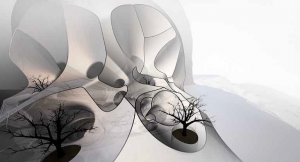 Please join us on March 18! Visit our facebook page.
Please join us on March 18! Visit our facebook page.
A few words from the artists ….
From Architect Derek Kaplan…
What follows began with an open-ended question about the relationship between architecture and sustainability.
Standard “green” procedure formulates what architecture can offer sustainability in the terms of energy efficiency, recycled building materials, renewable energy sources, life cycle costs, material embodied energy, urban density and economies of scale, revised patterns of habitation and transportation, spaces for localized production of necessities like potable water, urban gardening/farming, etc. All these issues are, and increasingly will be, important to address. However, these bracketed lines of problem-solving respond to questions that are structured by the conceptual foundations of modern architecture, in which design possibility is defined by a functional positivism that prioritizes system optimization above all else. There are other forms of architectural thought which start from different kinds of premises — the history of architecture demonstrates many — and that lead to architectural possibilities that are difficult destinations to access through the logic of modern architecture. The architecture of this proposal is one such possibility that falls outside of modern architectural thought, in which value leads function, instead of function leading value.
The proposal begins by resurrecting the possibility of large-scale rock-cut architecture by means of a technological update to its method of production, using currently existing technology. It is not a general concept for rock-cut architecture as a material means of producing our cities. Rather it is for the production of one very specific piece of architecture that is currently absent: a venue for future global environmental summits that is fundamentally other, a space removed from every context mapped by standardized habits — to offer an architectural starting point for addressing the fundamental antinomy between sustainability and the lifeworld as structured by capitalism. The exhibition hopes to articulate a few key features of the question that leads to this as the answer.
From Giorgio Magnanensi
Teatro dell‘Udito /CIRS
for violin, viola, cello, double bass, 10 spatialized electronic musicians, live interactive video and live electronics.
This piece is a further investigation of my teatro dell’udito series, which explores techniques of collage and assemblage of heterogeneous forms with a programmatic character. The fragmented nature of these events underlines their character of work in progress: a sort of tale without beginning and ending, a permeable space declaring its non-obstruction to diverse voices and soundscapes.
I’ve been working for some time exploring the possible interactive connections between movement, sound and video with the goal of developing a portable and self-contained system which could allow me to perform live with an instrumental ensemble, a dance company, any group of people or all these things together. With this project I would like to further develop aspects of the collaborative process involved in the creation of a new work and implement an efficient and flexible computer based system for an interactive and generative audio-visual instrument, which would allow audience member to engage on an active role in the co-creation of the soundscape.
With this project I would like to expand the level of interactivity beyond a purely technical (sound) level to one where both performers and audience are fully aware of how their movements are affecting the environment and of what that means in a formal context which articulates a synesthetic “zone” which modularity allows for greater flexibility and self-generative processes. The resulting sound texture is not merely the addition or subtraction of a number of isolated events, but is a more complex combination of sound events that works in a strategy of an imaginary scenography: a scenography informed by a continuous search for original relations between movement, space (psychological one included) and sound.
